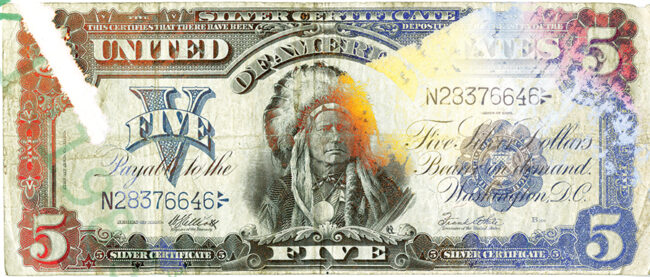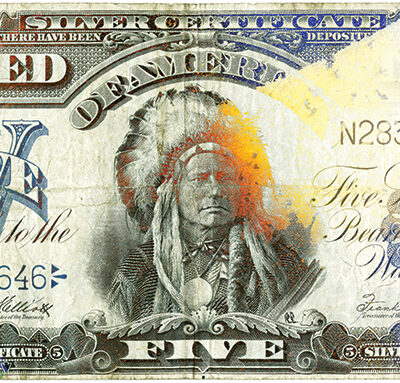Digitized, engraved image of authentic U.S. currency combined with my original abstract watercolor image, layered in Photoshop and output as a permanent pigment print. The Chief, although not identified on the note, is Sioux Chief, Running Antelope.
Born Takota Iyanke in 1821, Chief Running Antelope was a leader of the Hunkpapa. Not only was he a famous warrior and diplomat, but he was also widely said to have been the greatest orator of the Sioux nation.

Among some noticeable aspects of his life, he was brother of Rain in the Face, and was a close advisor to Sitting Bull during the Prairie Indian Wars of the west. Along with many other prominent Sioux leaders, he was a signer of the Treaty of 1868 and though he had argued in good faith for compromise with the U.S. Government, he would later regret it.
After being moved to Standing Rock Reservation in the Dakotas, Chief Running Antelope would be the appointed leader of the Last Great Buffalo Hunts in 1882 and 1883.
He died around 1897 and is buried at Little Eagle, in Standing Rock.
It was in 1899 that the only US paper money with a Native American Indian Chief was issued by the U.S. Mint. Full of splendid detail that almost captures the essence of Chief Running Antelope, that simple $5 note caused a scandal.
Whether it was creative license by Civil War photographer Alexander Gardner, ignorance by engraver George F.C. Smilie, or an embarrassing combination of both, it is widely understood that the Bureau of Engraving and Printing attributed a Pawnee headdress to a Sioux Chief.
According to Jeff Smith of TreasuredStocks.com, ”The story is that Chief Running Antelope is shown wearing a Pawnee head dress, not Hunkpapa, because the one the Chief actually wore was too tall for the engraving. Another version of that story is that the Chief was told to wear the Pawnee head dress during the photographic session which he adamantly refused to do. Either way, the head dress shown on his head is Pawnee.“
The considerable cultural gaffe outraged the Sioux and, as it did so well, the U.S. Government decided to take it back. The $5 paper note was discontinued and since then, Native American Indians have been only on our coin currency.
Prices range from $50 for “dollar” size print to $1250 for a mounted, 5 feet wide image.

(Running Antelope in his later years)
Ultimately the 1899 Large Silver Certificate bearing the image of Chief Running Antelope had the distinction of being the only US paper currency to have the image of a Native American Indian Chief.






















































